
Ebisu Station is a railway station in the Ebisu neighborhood of Tokyo's Shibuya ward, operated by East Japan Railway Company and the Tokyo subway operator Tokyo Metro. The station is named after Yebisu Beer, which was once brewed in an adjacent brewery, and which is itself named for the Japanese deity Ebisu.
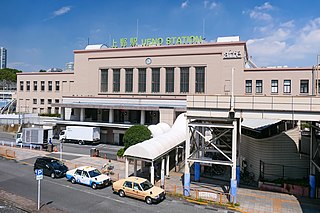
Ueno Station is a major railway station in Tokyo's Taitō ward. It is the station used to reach the Ueno district and Ueno Park—which contains Tokyo National Museum, The National Museum of Western Art, Ueno Zoo, Tokyo University of the Arts and other famous cultural facilities. A major commuter hub, it is also the traditional terminus for long-distance trains from northern Japan, although with the extension of the Shinkansen lines to Tokyo Station this role has diminished in recent years. A similar extension of conventional lines extended Takasaki Line, Utsunomiya Line and Jōban Line services to Tokyo Station via the Ueno-Tokyo Line in March 2015, using existing little-used tracks and a new viaduct; the Ueno-Tokyo Line connects these lines with the Tōkaidō Main Line, allowing through services to Shinagawa, Yokohama, Odawara and Atami stations.

Akihabara Station is an interchange railway station in Chiyoda, Tokyo, Japan. It is at the center of the Akihabara shopping district specializing in electronic goods.

The Tokyo Metro Hibiya Line is a subway line in Tokyo, Japan, owned and operated by Tokyo Metro. The line was named after the Hibiya area in Chiyoda's Yurakucho district, under which it passes. On maps, diagrams and signboards, the line is shown using the color silver, and its stations are given numbers using the letter "H".

The Tobu Isesaki Line is a Japanese railway line operated by the private railway company Tobu Railway, extending from Tōbu-Dōbutsu-Kōen Station in Saitama to Isesaki Station in Gunma Prefecture. The Isesaki Line can refer to the entire section between Asakusa - Isesaki and Oshiage - Hikifune, but from March 2012, the 41.0 km (25.5 mi) section south of Tōbu-Dōbutsu-Kōen was branded as the Tobu Skytree Line in conjunction with the opening of the Tokyo Skytree tower.

Ginza Station is a subway station in Chūō, Tokyo, Japan, operated by the Tokyo subway operator Tokyo Metro. It serves the Ginza commercial district, and is the fourth-busiest Tokyo Metro station after Ikebukuro, Ōtemachi, and Kita-senju.

Naka-meguro Station is a railway station in Meguro, Tokyo, Japan, jointly operated by Tokyu Corporation and Tokyo Metro. Despite its name, the station is not located in Nakameguro, but in the neighboring Kamimeguro district.
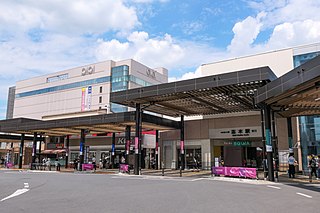
Shiki Station is a passenger railway station located in the city of Niiza, Saitama, Japan, operated by the private railway operator Tobu Railway. Despite its name, the station building is not actually located in Shiki. The city of Shiki has only one station, Yanasegawa Station, which is the next stop after Shiki Station on the Tōbu Tōjō Line.

The Tobu 50000 series is a DC electric multiple unit (EMU) commuter train type operated by the private railway operator Tobu Railway in Japan since March 2005, manufactured by Hitachi to its "A-train" concept. The trains represent the first use of aluminium body cars on Tobu commuter trains. They are also the first Tobu trains to feature bilingual automated passenger announcements.

The TJ Liner is a limited-stop "Home Liner"-style service to and from Ikebukuro Station in Tokyo on the Tobu Tojo Line operated by the private railway operator Tobu Railway in Japan since June 2008.
Home Liner (ホームライナー) is the generic name given to limited-stop commuter train services operated by railway companies in Japan, which require the purchase of a supplementary jōsha seiriken (乗車整理券) or Liner Ticket (ライナー券) in addition to the base fare ticket. The supplementary ticket guarantees passengers a seat on board. This article describes all commuter services in Japan fitting this definition, regardless of whether their names actually include the title "Home Liner".

Kayabacho Station is a subway station in the Nihonbashi neighbourhood of Chūō, Tokyo, Japan, operated by the Tokyo subway operator Tokyo Metro.
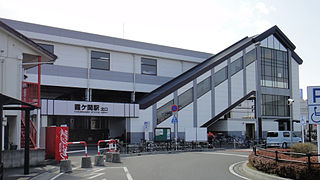
Kasumigaseki Station is a passenger railway station located in the city of Kawagoe, Saitama, Japan, operated by the private railway operator Tōbu Railway.

Koshigaya Station is a passenger railway station located in the city of Koshigaya, Saitama, Japan, operated by the private railway operator Tōbu Railway.

Kita-Koshigaya Station is a passenger railway station located in the city of Koshigaya, Saitama, Japan, operated by the private railway operator Tōbu Railway.

The Tobu Skytree Line is a section of the Tobu Isesaki Line operated by the private railway company Tobu Railway, extending from Asakusa Station in Tokyo to Tōbu-Dōbutsu-Kōen Station in Saitama Prefecture. Some trains from the line continue to the Tokyo Metro Hibiya Line and Tokyo Metro Hanzōmon Line. This section was branded the Tobu Skytree Line on 17 March 2012 in conjunction with the opening of the Tokyo Skytree Tower.
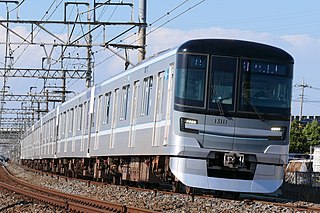
The Tokyo Metro 13000 series is a Japanese DC commuter electric multiple unit (EMU) train type operated by the Tokyo subway operator Tokyo Metro on Tokyo Metro Hibiya Line and Tobu Skytree Line inter-running services. Introduced into service on 25 March 2017, a total of 44 seven-car sets were built by Kinki Sharyo between 2016 and 2020 to replace the 03 series fleet.
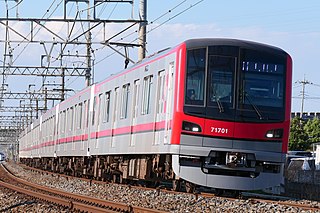
The Tobu 70000 series is a Japanese DC electric multiple unit (EMU) commuter train type operated by the private railway operator Tobu Railway on Tobu Skytree Line and Tokyo Metro Hibiya Line inter-running services since 7 July 2017.

The Tobu 2000 series was a DC electric multiple unit (EMU) commuter train type operated by the private railway operator Tobu Railway in Japan between 1961 and 1993.
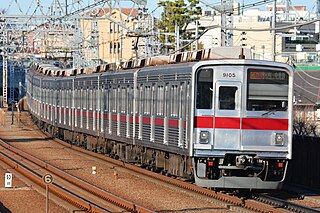
F Liner is the name for the fastest through service train among five railway companies: the Tobu Railway, Seibu Railway, Tokyo Metro, Tokyu Corporation and Yokohama Minatomirai Railway.



















